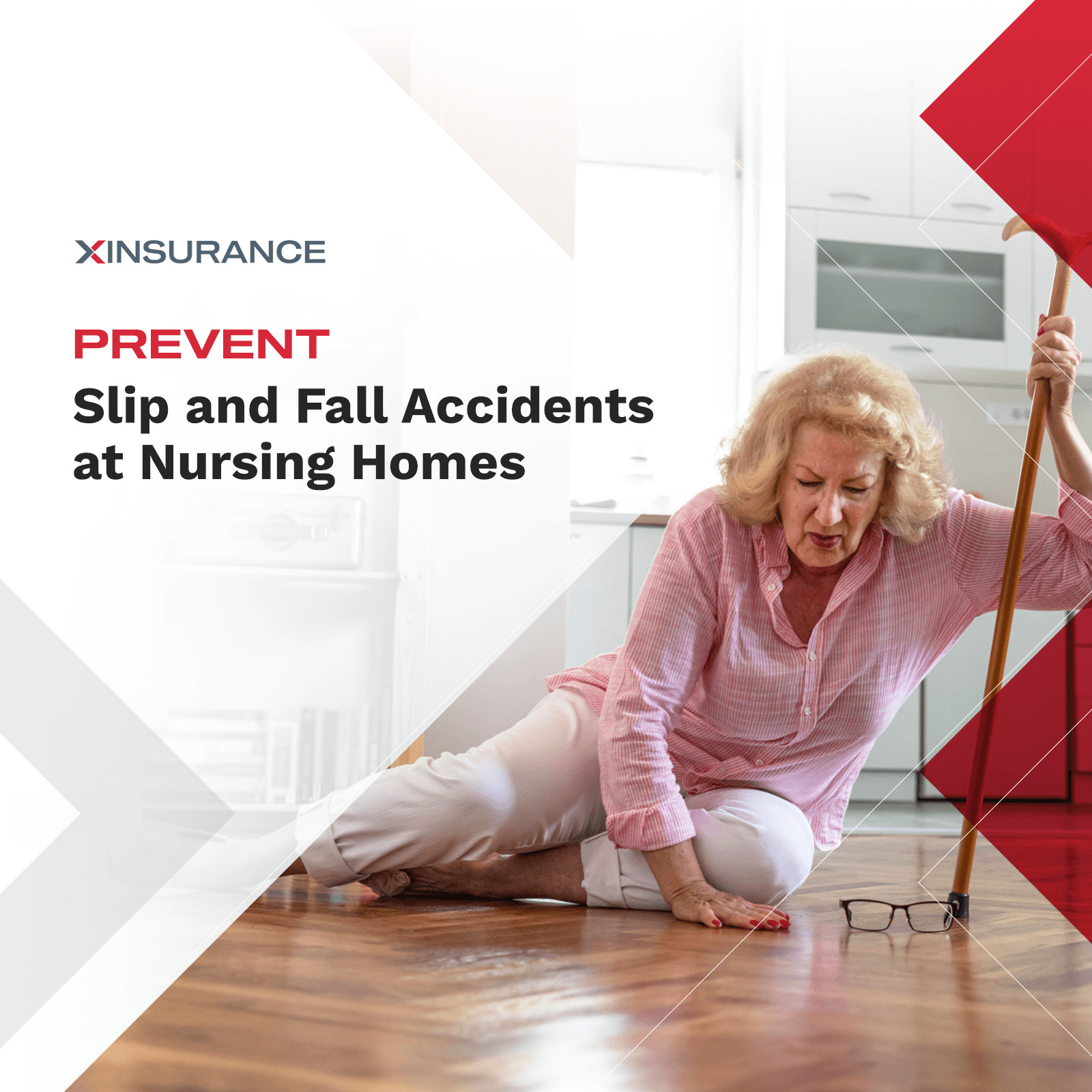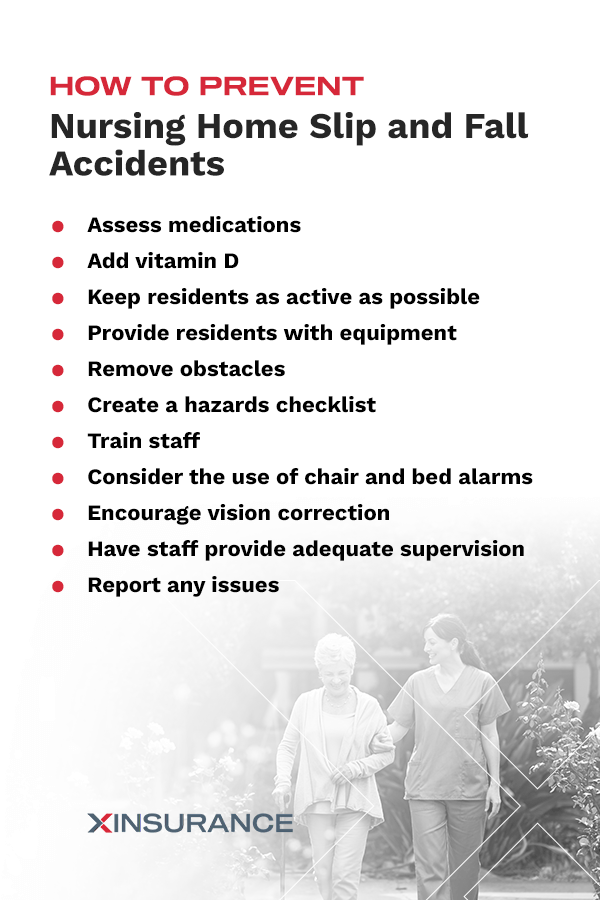
Prevent Slip and Fall Accidents at Nursing Homes
It can happen in an instant — a nursing home resident is walking when suddenly they trip over a loose piece of carpet and fall. Or, they slip and fall on a wet floor and break a bone. Falls are fairly common among people of all ages, and they become more common as people get older. They are among the leading causes of preventable injuries and deaths in the U.S.
Preventing slip and fall accidents is the first step to protect residents at a nursing home and ensure their health and safety. Having insurance coverage for nursing homes is also important as it can provide financial protection if a resident or visitor is hurt in an accident. With the appropriate policy terms and limits, insurance coverage may provide a defense against potential lawsuits and claims and can give you true peace of mind.
Slip and Fall Accidents Statistics
How common are slip and fall accidents or other nursing home accidents? In 2018, falls accounted for 32% of all non-fatal, preventable injuries. They also accounted for 22% of deaths following an injury. About one of every four people over the age of 65 falls each year, and many of those falls do not get reported to a medical professional. A person who falls one time has an increased risk of falling a second time.
Although not all falls lead to injuries, about 20% do cause significant injuries. According to data from the Centers for Disease Control and Prevention (CDC), each year, falls are responsible for:
- More than 95% of hip fractures.
- 3 million emergency department admissions among people over age 65.
- More than 800,000 hospitalizations due to injury, most often hip fractures or head injuries.
Nursing homes see more falls each year than in other settings. Three out of four nursing home residents fall each year, and the average nursing home sees around 100 falls annually. Nursing home residents account for around 18% of falls that result in death.
Cost of Falls Among Older Adults
The CDC reports more than $50 billion is spent on medical care for falls that aren’t fatal, and $754 million is spent on medical costs for fatal falls. Medicare covers many of the medical costs related to non-fatal falls at $29 billion per year, while Medicaid covers around $9 billion. Around $12 billion is spent by out-of-pocket payers or private insurance.
Risk Factors for Falls
What makes older adults and nursing home residents more likely to experience a fall compared to people in other demographics? A number of factors can increase an older individual’s risk of falling, including:
- Vision difficulties
- Weakness in the lower part of the body
- Vitamin D deficiency
- Taking certain medications
- Difficulties with balance or walking
- Shoes that do not fit properly
- Foot pain
- Uneven or broken stairs
- Clutter on the floor, including loose carpeting or tiles
The CDC reports that in many cases, a combination of risk factors contributes to a fall. For example, an older adult who has difficulty maintaining their balance can be more likely to fall if they trip over a loose tile on the floor compared to a person without balance difficulties.
A fear or worry about falling can also put a person at an increased risk of falling. When an individual is concerned about their fall risk, they may decide to cut back on their activities. They may also do this following a fall that did not cause an injury. Adopting a less-active lifestyle can cause a person to become physically weaker, which can put them at a higher risk for falling when they do move around.
How to Prevent Nursing Home Slip and Fall Accidents
Fall and accident prevention in nursing homes and assisted living facilities is a multi-pronged process. Depending on a person’s specific risk factors, there are many changes and improvements to make to help lower the risk of slip and falls:
- Assess medications: It’s common for assisted living residents to be taking a variety of different medications. The side effects of certain medicines or from the interactions between different medications can elevate a person’s risk of falling. Some medications can make people drowsy or confused. The interactions or side effects might also affect someone’s balance or cause a delay in reaction time. Medical staff should review a person’s medication list to make sure the person isn’t taking a combination of medicines that increases their fall risk. In some cases, changing doses or switching to a different type of prescription might be in order.
- Add vitamin D: Low levels of vitamin D can put people at an increased risk for falls. Several reviews of medical studies have suggested that providing residents with vitamin D supplements per physician’s recommendation helped reduce the number of falls that occurred between 17% and 19%.
- Keep residents as active as possible: A sedentary lifestyle can increase a resident’s fall risk. Offering activity programs that help residents maintain or develop their strength or improve their balance can significantly lower their risk of falling.
- Provide residents with equipment: Providing nursing home residents with assistive devices, such as walkers, canes or wheelchairs, helps to prevent falls. Outfitting the equipment with items such as seat belts or rubber grips can further minimize a person’s fall risk.
- Remove obstacles: A number of hazards or obstacles are present throughout a nursing home that can increase residents’ fall risk. Loose tiles or torn carpet are easy for people to trip over. Items left in the hallways, such as tray carts, can be walked into or tripped over. A nursing home should have protocols in place for reporting and removing obstacles and hazards.
- Create a hazards checklist: Part of the protocol for removing or reducing hazards in a nursing home can be creating a checklist. The list can describe potential obstacles, such as loose carpeting, broken tiles or objects left on the floor. At the start of a shift, employees can walk through the area they will be working in and use the list to check for and correct any hazards.
- Train staff: The employees at a nursing home or assisted living facility who interact with residents regularly need to be aware of potential hazards and should know what they can do to correct those hazards. For example, staff should be aware of the fact that slippery floors create a fall risk. They should also know where any barricades or caution signs are stored so they can take action quickly to mark off a hazardous area and protect residents.
- Consider the use of chair and bed alarms: Chair and bed alarms feature pressure sensors that sound an alert when weight is taken off of them. Research has suggested that chair or bed alarms can be a useful part of a fall prevention program but aren’t sufficient for preventing falls on their own.
- Encourage vision correction: Older adults may develop vision problems, such as cataracts, age-related macular degeneration and glaucoma. Eye conditions can affect a person’s vision, making things appear blurry. Not being able to see fully can put a person at a greater risk of tripping and falling. If possible, assisted living facilities should encourage residents to correct problems with their vision. Vision correction can be as simple as having someone wear glasses or as involved as having surgery to remove cataracts.
- Have staff provide adequate supervision: The staff of a nursing home should be able to adequately supervise residents, particularly residents who have an increased risk of falling. Providing adequate supervision means having enough people working at any time. It also means having a nurse or nursing assistant on hand to supervise people during activities that involve physical movement, such as taking a walk or exercising in an aerobics class.
- Report any issues: Staff should be encouraged and expected to report safety issues they see and any falls that occur. Accurate reporting allows for the correction of those concerns. Reporting falls also allows a resident to get the medical care they need and the nursing home to make changes to avoid another fall in the future.
What to Do If an Accident Happens at Your Facility
The Agency for Healthcare Research and Quality (AHRQ) provides a detailed description of what the staff at a nursing home or assisted living facility should do if a patient falls. The first things to do are monitor the resident who fell and investigate the circumstances under which the fall occurred.
Resident monitoring should occur for at least 72 hours after the fall. Part of the monitoring process includes identifying and treating any injuries that occurred after the fall. It also involves keeping track of vital signs, blood pressure, and heart rate. If a person is diabetic, their blood sugar levels should be monitored, as well. Other tests might be needed, depending on the patient’s health.
Someone from the facility should investigate the conditions under which the fall took place. The sooner the investigation takes place, the better. It might be the case that the staff needs to guess what happened if no one else saw the fall. They may be able to make an educated guess based on the location of the fall and any objects around the area.
All the details of the fall need to be recorded and reported. The exact process and requirements for filing an incident report after a fall can vary by state, so it’s important a facility follows the rules of the state it is located in.
Details to include in the incident report are:
- Day, date, and time of the fall
- Location
- Fall type
- Possible cause of the fall
- What the resident was doing when they fell
- Staff who were present (if any)
- Footwear worn by the resident
- Use of assistive devices, chair and bed alarms or restraints
Along with filing an incident report, staff from the nursing home should contact the resident’s primary care provider and inform them of the fall. If possible, the facility should put practices into place to intervene and prevent future falls within the first 24 hours. Possible interventions include providing the resident with more assistance and supervision, increasing the use of assistive devices and making sure they have footwear that fits.
How Liability Insurance Coverage for Nursing Homes Works
Even with the best preventative measures in place, accidents such as slips and falls can happen at nursing homes. In some cases, a resident’s fall can be directly linked to the negligent behavior of one or more of a facility’s employees. If that is the case, the resident or their family members might sue the nursing home, seeking financial compensation for any injuries experienced as a result of the fall.
Liability insurance for nursing homes comes in two forms: general liability insurance and professional liability insurance. General liability insurance coverage may provide financial compensation as a result of a long list of risks, such as damage to property and bodily injury.
Professional liability insurance, also called errors and omissions, may provide financial protection if an employee is negligent. Errors and omissions insurance can provide coverage for negligence committed by administrators or individuals who provide direct medical care. For example, if a nurse is distracted and accidentally gives a resident the wrong medication or wrong dose of medication and that patient becomes disoriented and falls, professional liability insurance could provide coverage if the resident or their family decides to sue.
A policy provides protection and a defense up to your policy limits if an incident, claim or lawsuit occurs. Liability insurance may not cover everything, so be sure to review your policy terms and limits to understand how you are protected.
Falls aren’t the only accidents or issues liability insurance coverage may protect against. A general liability policy may also protect your facility if any of the following occur:
- An employee steals something that belongs to a resident.
- A resident becomes very ill or dies after a nurse or another staff member administers an incorrect dose of medicine.
- A resident develops bed sores or another physical ailment because they are ignored or neglected by nursing staff.
General and professional liability coverage are just two examples of insurance policies that can help protect a nursing home. A range of other policies, such as alleged assault liability, communicable disease coverage and business auto coverage can provide your facility the protection it needs.
Get True Peace of Mind With an Insurance Quote from XINSURANCE Today
Nursing homes and assisted living facilities need insurance that provides appropriate coverage against a wide range of risks, including employee negligence, property damage, and damage to the property or possessions of residents. XINSURANCE aims to provide solutions to our clients with all-in-one coverage, providing the policies and protection you need in a single insurance policy.
Getting the right liability insurance policy can give you true peace of mind that your facility has the coverage it needs should an accident happen. To learn more about our all-in-one insurance coverage options for assisted living facilities and senior living centers, contact us today.

Rick J. Lindsey hails from Salt Lake City, Utah. He began working in the mailroom of his father’s Salt Lake City insurance firm, getting his introduction to the business that became his lifelong career. Rick J. Lindsey quickly rose through the ranks while working in nearly every imaginable insurance industry job. As an entrepreneur, specialty lines underwriter, claims specialist, risk manager, and a licensed surplus lines broker, Rick J. Lindsey is highly skilled in all levels of leadership and execution. As he progressed on his career path, Rick J. Lindsey discovered an urgent need for insurers willing to write policies for high-risk individuals and businesses. He was frequently frustrated that he could not provide the liability protection these entities desperately needed to safeguard their assets. He also formed the belief that insurance companies acted too quickly to settle frivolous claims. Rick J. Lindsey decided to try a different approach. He started an insurance company and became the newly formed entity’s CEO. This opportunity has enabled Rick J. Lindsey to fill a void in the market and provide a valuable service to businesses, individuals, and insurance agents who write high-risk business. XINSURANCE also specializes in helping individuals and businesses who live a lifestyle or participate in activities that make them difficult for traditional carriers to insure. If you’ve been denied, non-renewed, or canceled coverage, don’t give up quite yet. Chances are XINSURANCE can help.





